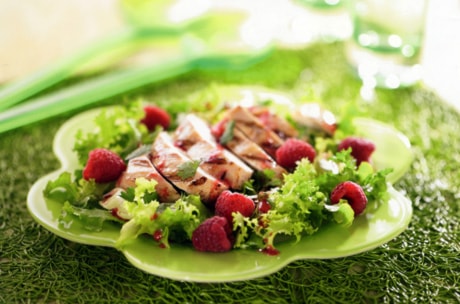It’s called Ukee and it is a very special red raspberry named for the First Nations people who reside in the small British Columbia town of Ucluelet, in Barkley Sound on the west coast of Vancouver Island.
It’s not the only berry to use the province’s local First Nations names, says Chaim Kempler, research scientist with Agriculture and Agri-Food Canada’s Pacific Agri-Food Research Centre (PARC) in Agassiz, B.C.
“All our strawberry and raspberry varieties are given First Nation names,” he explains. “It was started by a previous breeder and the tradition continues.”
He adds that this was deemed appropriate so that each would be easily identified as originating from the B.C. programs. The naming decision is important since some of the cultivars — for example, Chilliwack, Skeena and Chilcotin raspberries and Totem strawberry — have received worldwide recognition.
More than 80 per cent of Canada’s summer raspberries are grown in British Columbia, mainly in the Fraser Valley. They are grown on 4,000 acres by 175 growers and result in 10 per cent going to the fresh market and 40 per cent for processing.
“We are the largest producer of raspberries using a machine-harvesting technology to pick the berries,” says Kempler, who has worked as a berry breeder in Agassiz since 1978.
The native of Israel who graduated from the University of Guelph in southwestern Ontario adds that scientists like him have been developing new berries for the Pacific Northwest since the 1950s.
“We work closely with local growers and other researchers to ensure we develop new high-quality varieties.”
For example, Stolo, a strawberry plant released in 2007 from PARC, is highly valued because it resists root weevils and is very productive. This can translate into increased revenue for growers.
Kempler says productivity and resistance are important factors for a variety to be adopted and grown commercially.
“Varieties with natural resistance to diseases and pests help growers save money and help the environment by reducing the amount of pesticides and fungicides they use.”
“Each year we plant between 4,000 to 10,000 strawberry seedlings and 3,000 to 7,000 raspberry seedlings from crossed parent lines,” says Kempler.
“However, only about 0.5 per cent of these show promise with the desired characteristics for further development.”
Scientists are continually researching in hopes of introducing new sources of genetic material that will improve berries for consumers. For example, some berries may contain genes which could help overcome evolving plant diseases and create new berries with added nutritional benefits, better market appeal and high fruit quality.
The five-week raspberry harvest season begins in early July, says Kempler, and “generally the crop is above average” in British Columbia despite a hard winter, he said, adding that for anyone driving in the Abbotsford area “they will see raspberries growing from end to end.”
Here are two distinctly different recipes using fresh ruby-red raspberries. The first, a chicken salad, has the berries in the dressing. It makes a colourful light summer meal.
The second is a decadent dessert in which raspberries play a starring role as they crown the chocolate base. This torte is best eaten the day after it is made. Serve with whipped cream.
Grilled Chicken and Raspberry Salad
500 ml (2 cups) fresh raspberries
30 ml (2 tbsp) red wine vinegar
30 ml (2 tbsp) granulated sugar
125 ml (1/2 cup) olive oil
2 ml (1/2 tsp) each salt and pepper
4 boneless skinless chicken breasts
2 l (8 cups) torn mixed salad greens
50 ml (1/4 cup) fresh coriander, chopped
In a blender, puree together 250 ml (1 cup) of the raspberries, vinegar and sugar until smooth. Strain through sieve into bowl. Whisk in oil, salt and pepper. Remove 45 ml (3 tbsp) of the dressing and toss with chicken; cover and marinate in refrigerator for 30 minutes. Chill remaining dressing.
Place chicken on greased grill over medium-high; close lid and grill for 10 to 12 minutes or until no longer pink inside, turning once. Slice chicken. Arrange greens on 4 plates; top evenly with sliced chicken and remaining raspberries. Drizzle with dressing; sprinkle with coriander. Serve immediately.
Makes 4 servings.
Nutritional information per serving: 393 calories, 28 g protein, 25 g fat and 15 g carbohydrates.
Recipe source: Foodland Ontario.
Chocolate Raspberry Torte
300 ml (1 1/4 cups) all-purpose flour
175 ml (3/4 cup) granulated sugar
125 ml (1/2 cup) cocoa powder
5 ml (1 tsp) baking powder
Pinch salt
250 ml (1 cup) sour cream
1 egg, beaten
125 ml (1/2 cup) milk
5 ml (1 tsp) vanilla
625 ml (2 1/2 cups) raspberries
30 ml (2 tbsp) packed brown sugar
10 ml (2 tsp) grated orange rind
In large bowl, sift together flour, granulated sugar, cocoa, baking powder and salt. In a separate bowl, combine sour cream, egg, milk and vanilla. In another bowl, gently combine 375 ml (1 1/2 cups) of the raspberries, brown sugar and orange rind.
Add milk mixture to flour mixture; mix well. Spread batter evenly into greased 2.5-l (9-inch) springform pan. Spoon raspberries over top, leaving 1-cm (1/2-inch) border uncovered.
Bake in a 180 C (350 F) oven for 30 to 35 minutes or until tester comes out clean; let cool. (Raspberry centre will seem wet but will firm up as it cools.) Cover with plastic wrap; chill for at least 4 hours or up to 24 hours. To serve, top with remaining raspberries.
Recipe source: Foodland Ontario.
